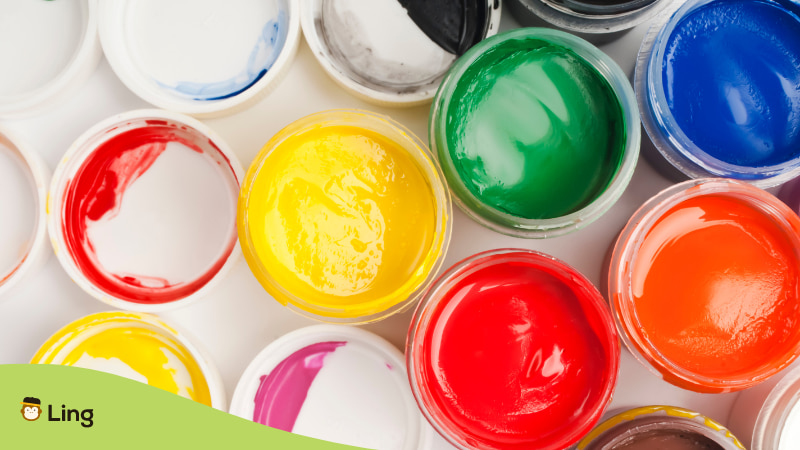Colors in Thailand have an interesting connection with culture. For some countries, the color of the flag is synonymous with the country itself. But for Thailand, it goes even deeper than that. For that reason, it’s important to learn about the names of colors in Thai culture.
At the same time, you should also learn some essential vocabulary to communicate correctly with the locals. This blog post will help you understand the language and mindset of the Thai people a little bit better.
How To Say The Colors Names In Thai
In Thailand, colors have deep meanings tied to the country’s culture and history. When you’re exploring places like Bangkok or Phuket, knowing what these colors mean can make your trip even better.
Let me teach you the basic Thai words for colors and how to use them. This way, you can talk about and understand the colorful world of Thailand better.
As you may notice, the word ‘sii’ (สี) is usually placed before the names of colors in Thai. It actually means color and is used as a classifier of sorts that is placed before the name.
If you want to say light or dark when talking about a color, you would say ‘orn’ (อ่อน) for light and ‘khem’(เข้ม) for dark. You place these after the color name, so dark blue, for example, would be ‘sii nam-ngurn khem’ (สีน้ำเงินเข้ม).

The Meanings Of Colors In Thai Culture
As I spoke about before, there is some significance for the colors in the culture. Each day is assigned one or more lucky and unlucky colors. The reasoning behind this system is due to the Thai names for the days of the week. Each name corresponds to a planet or star in the solar system, which in turn corresponds with certain gods who are said to protect that day.
For instance, the Thai name for Monday, ‘Wan Jan,’ is associated with the Moon. Therefore, the color yellow is considered lucky for this day. These gods have an associated color, which is used as the lucky color for that day.
| Day | Lucky Color | Unlucky Color |
|---|---|---|
| Monday | Yellow | Red |
| Tuesday | Pink | Yellow or White |
| Wednesday (Daytime) | Green | Pink |
| Wednesday (Nighttime) | Gray | Orange-Red |
| Thursday | Orange or Brown | Purple |
| Friday | Light Blue | Dark Blue or black |
| Saturday | Purple or Black | Green |
| Sunday | Red | Blue |
While this is an ancient custom, some people still follow this system. Of course, it is not strictly followed every day. It is more often relegated to special occasions, Thai holidays, or certain superstitious dates and religious events. You will probably find that people do follow the ‘unlucky color’ schedule to an extent. It is better to be safe than sorry, after all.
Then there are people’s birth colors. These are considered the luckiest of all for the individual, so people may choose to wear their color when they want luck to be on their side. Yellow is heavily associated with the royal family for this reason.
Otherwise, while the tradition holds historical significance, its observance varies among the modern Thai population. Still, understanding this aspect of Thai culture is worth learning, and sharing this knowledge of ancient tradition can be a conversation starter with locals.
The Deep Meaning Of Thai Colors
Colors in Thailand have stories and deep meanings. Let’s learn what some colors mean in Thai culture:
- Red (สีแดง, sii deng): In Thailand, red is a symbol for Sundays. But it’s also a deep reminder of the brave Thais who spilled their blood to keep their country free.
- Yellow (สีเหลือง, sii luang): Yellow is the color of Mondays. It’s tied to King Rama IX, also known as King Bhumibol. He was born on a Monday. When Thais wear yellow, especially on Mondays or during big royal events, it’s a sign of respect and love for him.
- Blue (สีน้ำเงิน, sii nam-ngurn): Blue is special for Fridays because it’s linked to Queen Sirikit, who was born on a Friday. Blue also stands for the Thai royal family and is a nod to Thailand’s allies during the First World War.
- Green (สีเขียว, sii kiao): Wednesday in Thailand is marked by green, linked to the day’s guardian, Mercury. A tale tells of Phra Isuan turning 17 elephants into powder, wrapped in green, as a gift to the King. By evening, influenced by the Hindu god Rahu, colors shift to grey, orange, or red.
- Pink: Pink is the color for Tuesdays. The story goes that King Rama IX, or King Bhumibol, wore a pink shirt because his astrologer said it was lucky. So, pink has a touch of royalty.
- White (สีขาว, sii kao): In Thailand, white speaks of purity and the peaceful teachings of Buddhism. While black is now the color for mourning, white is still chosen for prayers and holy events.
As you can see, the names of colors in Thai tell stories. They remind people of their history, kings and queens, and beliefs. When you see these colors in Thailand, you’ll now know the special stories behind them. It’s a beautiful way to feel closer to the Thai people and their way of life.
Learn The Names Of Colors In Thai With Ling!
So there you go, the somewhat complicated back story of the significance of colors in Thailand. I hope that knowing this now motivates you to learn the colors in Thai and possibly even consider following the system.
I know I have started doing so, even if subconsciously. Next time you walk around the country, look at the colors people are wearing to see how many people actually follow this system. It could make for a great way to practice the new vocabulary, too.
So, do you want to learn Thai or maybe another language? Then you should check out the Ling app. It’s simple and fun to use. You can practice speaking, reading, and writing in Thai.
And if you’re curious about other languages, the app offers over 60 of them for you to explore. With the Ling app, you can learn whenever you have some free time, no matter where you are.
Download the Ling app from the App Store and Google Play now. Start learning Thai or any of the 60+ languages today!
Updated by: Jefbeck






























































